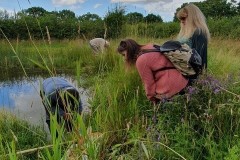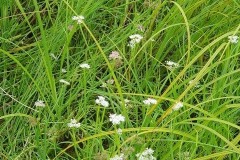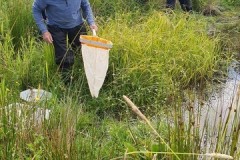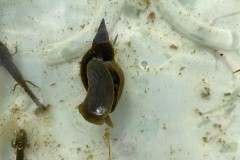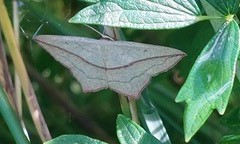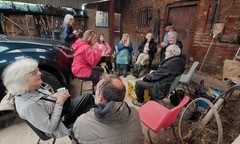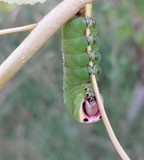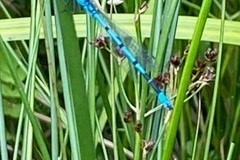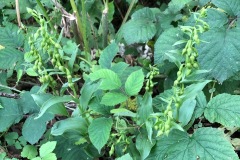Leader: John Scott,
Members present: NB, CH, JS & PS, LH & Tim, JB, CP, TS & GS & JS, AT.
A visit to John Scott’s farm to spot butterflies and do some pond dipping. The weather had been rather inclement with some heavy downpours earlier in the day. We were extremely lucky that the sun came out for the afternoon.
As we walked to the first pond, many butterflies were in evidence.
Painted Lady
Tortoiseshell
Meadow Brown
Gatekeeper
Small Skipper
Around the pond we noted Round Fruited Rush and Water Plantain along with the more unusual Lesser Water Plantain. Some of the group remained at the first pond and may wish to submit additional findings and possibly photographs! Emperor Dragonfly was noted here and, I believe, some young smooth and great crested newts.
At the second pond, John’s new solar pump to top up the pond was admired! Jim noted:
Common blue damselfly
Azure damselfly (almost sure it was Azure rather than the Common blue) – photo below
Blue tailed damselfly
Common darter
We all walked around the edge of the wood planted by John and Louise around 2016. We admired many trees and shrubs and noted, in particular, the wild service tree (Sorbus torminalis) and the Black Poplar (Populus nigra). It was when John was inspecting his treasured black poplar that the Puss Moth caterpillar (Cerura vinula) was discovered – well three actually – eating the leaves! This provided great entertainment and excitement and much photographing! Photos below from Caroline B. including a Blood vein moth (Timandra comae).
As the rain couldn’t hold off any longer, we all went back to John’s barn and enjoyed tea (kindly provided by John’s sister Elizabeth) and, as it had been Colin’s birthday the previous day, Nora handed around Colin the Caterpillar cakes to celebrate!
Photos below by Caroline B.
It had been the intention to stay on to look for Purple Hairstreak butterflies but the rain stopped play.
A great afternoon, enjoyed by all.
Anna Thirlwell.
Leader: Catherine Palmer Also present: NB & CH
The Green-flowered Helleborine Epipactis phyllanthes was first discovered locally at Cusworth Park in 1975. Sadly, the population at its find-site was lost through re-landscaping during 2000 & 2003-4, but in 1986 another population had been found by Martin Limbert along the wooded eastern bank of the Lower Lake. These have been monitored almost every year since, with numbers peaking at about 100 (!) in 1999 (see The Naturalist (2015) 140: 48-56) but numbers have tended to dwindle ever since.
Last year (July 27 2022) Catherine Palmer led an enjoyable evening visit to Cusworth Park, which even during the severe drought, successfully located eight plants of E. phyllanthese.
This year (2023) on the afternoon of 5 July a preliminary survey by CAH & NB located 3 scrawny little plants on the east side of the lower lake, then a group of 11 plants, including several tall, healthy, floriferous specimens on the western side of the lower lake.
On 12 July the Nats undertook a thorough search in order to achieve a definitive assay of what may be Yorkshire’s last surviving E. phyllanthese population. The team assembled on the lawn between the Lower Lake and the Keepers Cottage (SE/551 039) at 1.30pm (just as it came on to rain (!) then carefully walked a circuit of the Lower Lake, commencing at the outflow stream, proceeding along the eastern side, returning along the western side and examining both sides of the path. OS Grid references for each plant or group of plants were recorded by Nora via the GPS app on her Iphone.
Results:
Table 1: Locations of Green-flowered Helleborines around the Lower Lake, Cusworth Park. Rows in bold relates to numbers of plants at particular locations.
| Side of Lower Lake East or West | OS Grid Ref. | Side of path L or R | Number of florets |
|---|---|---|---|
| East | SE/55224 03924 | R | 4 |
| East | SE/55247 03883 | R | 9 |
| East | SE/55256 03881 | L | 13 |
| East | SE/55266 03881 | L | 4 |
| East | SE/55266 03881 | L | 8 |
| East | SE/55266 03881 | L | 4 |
| East | SE/55266 03881 | L | 5 |
| East | SE/55266 03881 | L | 9 |
| East | SE/55265 03827 | R | 5 |
| East | SE/55265 03827 | R | 3 |
| East | SE/5525203745 | R | 9 |
| West | SE/55202 03836 | L | 15 |
| West | SE/55202 03836 | L | 11 |
| West | SE/55202 03836 | L | 13 |
| West | SE/55202 03836 | L | 4 |
| West | SE/55202 03836 | L | 0 |
| West | SE/55202 03836 | L | 4 |
| West | SE/55202 03836 | L | 9 |
| West | SE/55202 03836 | L | 6 |
| West | SE/55202 03836 | L | 10 |
| West | SE/55202 03836 | L | 3 |
| West | SE/55202 03836 | L | 4 |
| West | SE/55201 03842 | R | 6 |
| West | SE/55201 03842 | R | 9 |
| West | SE/55201 03842 | R | 6 |
| West | SE/55191 03858 | R | 10 |
| West | SE/55191 03858 | R | 14 |
| West | SE/55191 03858 | R | 3 |
| West | SE/55191 03858 | R | 6 |
| West | SE/55191 03858 | R | 9 |
| West | SE/55191 03858 | R | 12 |
| West | SE/55191 03858 | R | 6 |
| West | SE/55191 03858 | R | 5 |
Total 33 plants, 11 on the eastern side, 22 on the western side.
Group sizes were 1 plant (5), 2 plants (1), 3 plants (1), 7 plants (1) and 11 plants (1).
After the survey, we walked up to the Hall Café for celebratory refreshments. En route, we passed through the un-mown meadow, noting many seed heads of what we assumed were Southern marsh orchids. Butterflies casually encountered through this magnificent grassland and adjacent hedgerow were Comma, Meadow Brown, Ringlet, Brimstone and Small White.
CAH.
Leader: John Newton. Also present: CT & CH
Introduction:
The south-facing limestone crags, located at the north-western entrance to the Don Gorge are known to harbour good populations of Common Lizards Zootoca vivipara and Grass Snakes Natrix natrix and a remnant population of Slowworms Anguis fragilis. Early records of the herptile fauna are outlined in references 1, 2, & 3, though the strength of the current reptile populations both here and in the contiguous Dearne Valley has been established through active field-work over many years by today’s leader John Newton, Herptile recorder for the Sorby Natural History Society.
During the previous week John had visited the area to lay down squares of roofing felt for reptiles to hide beneath and to strategically place pieces of wood in sunny positions for lizards to bask on. These items were to form the targets for reptile searching during our visit.
Of butterflies, Ringlets, Meadow Browns, Gatekeepers and Small Skippers were active whenever the sun briefly shone.
Of the birds, a Common Buzzard was sailing overhead, Chris identified pairs of Bullfinches and Goldfinches by their calls. Song Thrush and Blackbird were in full song in lulls between the rain but the most persistently garrulous avians were Green Woodpeckers, two of which were seen, their presence no doubt associated with the numerous ant nests on the limestone grassland.
There being so little visible reptile activity, we detoured across the Conisbrough Viaduct, well used, even on this rainy day, by walkers and cyclists, pram pushers and sight-seers, to inspect the ravine of the Warmsworth Bat tunnel with its lush growths of ferns and bryophytes. On our return to the Cadeby side we inspected the magnificent colony of Dane’s Elder Sambucus ebulus, also known as Dwarf Elder and Danes Blood, growing on the down-stream side of the embankment leading up to the masonry of the viaduct. This colony, discovered by A.A.Dallman, Science master at the nearby Mexborough Secondary School, and one time president of the Doncaster Naturalists’ Society, had been known on this very spot at least since 1921 and monitored here sporadically by the Doncaster Nats ever since (see ref. 4). During our visit we counted 40 flowering spikes, some of which had spread onto the embankment of the adjacent Trans-Pennine Trail.
During our visit, John had pointed out numerous (but empty) lizard sunning sites, these including the wooden planks he had installed for the purpose, plus the ubiquitous discarded concrete railway sleepers. Sadly, with the day being so overcast our searches drew a blank, though many botanical goodies were encountered. However, as a final hoorah (!) in our last few minutes on site the clouds parted and immediately there were two common lizards basking on a sun-lit plank near the Cadeby railway tunnel … thanks John.
This compact area is extremely rich in all aspects of limestone wildlife and post-industrial ecology and would most certainly repay further visits.
References:
1) The history and distribution of Reptiles and Amphibians in South-east Yorkshire and theDoncaster district. The Naturalist (1973) 98: 121-132.
2) Notes on a collection of Kestrel pellets from Cadeby. Lapwing (1980) 12: 15-18.
3) Notes on the Slow-worm in southern Yorkshire. Yorkshire Naturalists’ Union Bulletin (1986) 6: 2-4.).
4) Dane’s blood on Cadeby Viaduct. The Doncaster Naturalist (2013) 2 (3): 129-130.
CAH.
